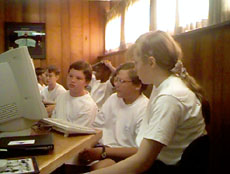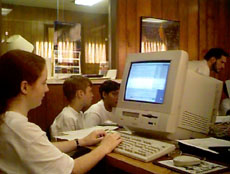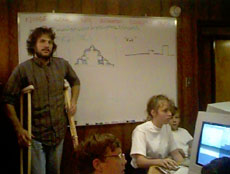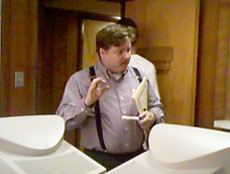|
July 18, 1997 The final day of the Shodor Education Foundation's Internet Explorers Club started today at 8:30. This was a big day for the Internet Explorers because today was the day that they were able to chat with scientists from across a broad spectrum of the United States. All of the IEC students were very enthusiastic about today and they showed it in their performance. The Internet Explorers began the day with a quick review of previously learned material. Next, they opened their global chatting program and began chatting amongst themselves. Shortly after, several scientists began to log on. The Internet Explorers were then given a numerical order in which they could inquire a question. Moderated by Shodor's intern Anne Thissen, the Internet chat went smoothly. The IEC students had several superb questions to ask the scientists. There actually were so many questions that the chat session ended before everyone had completed.
Next the students, after finishing their chat sessions, journeyed outdoors to Shodor's picnic tables to take their group photograph. This, quickly completed, allowed the students to return indoors in order to finish yesterday's Ebola model. The model, instructed by Jonathan Pahl, used data assembled by the students from day four. This data, collected via the Internet, reflected accurate and current information regarding the spread of the virus. Students seemed amazed by the ability of Stella® modeling to create graphs based on simple data constructed with this information. After completing the Stella® modeling, students were ready to begin their final activity as member's of the IEC program. Mike South, Shodor's resident mathematician and chief programmer, introduced the Explorers to Fractals. He explained that a Fractal "is a kind of object found in mathematics and nature in which each small part of the object resembles the whole object." For example, a major branch of a tree reflects the tree as a whole, even in a simpler form than the tree itself. Students worked through the Snowflake application designed by Mike South. The students seemed interested by the ability of the program to reflect the different iterations that go into the creation of a Fractal. By viewing and increasing the number of iterations in the math of a Fractal the way in which the Fractal is constructed becomes easily understandable.
Last Update: June 14, 1999 Please direct questions and comments about this page to WebMaster@shodor.org © Copyright 1998 The Shodor Education Foundation, Inc. |





